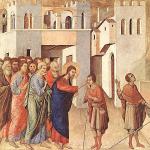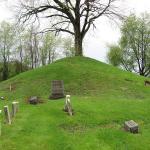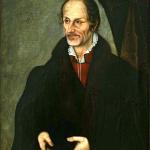Here’s an excerpt from a bit of whimsy I wrote a few years back on one of the ironies of the American Founding and our Puritan heritage:
As an example of what I mean, consider the curious interior of King’s Chapel in Boston. An amalgam of Puritan and Anglican heritage, it was assiduously scoured clean of any Romish imagery that might tempt the unwary Puritan into the sensuous worship that characterizes the benighted papist.
However, it is also a chapel which was essentially funded by the prosperous local burghers and young capitalists whom the American colonies produced with such fertility. It being only their due for such public-spirited generosity, the benefactors naturally received the thanks (one might even call it the “veneration”) of a grateful church in the form of dozens of statues and busts bearing their likeness which adorn every nook and cranny of King’s Chapel.
And so the Puritans achieved the overthrow of Rome and all its pomps and works — its cru-cifixes, stained glass, baroque saints, shrines and rosaries — and proceeded to put in place of all this Romish piety … the statues of a bunch of rich guys. Eventually, they also created a civilization in which the central architectural feat was no longer the Romish cathedral of ignorant superstitious Dark Age faith, but the sleek, modern skyscraper dedicated to the forthright worship of mammon.
Creation myth
All this was a bit awkward for the architects of the City on a Hill, so it was necessary to establish a Creation Myth for the new country that preserved something more ennobling than, “As a matter of fact, you can serve two Masters.”
But it couldn’t be a creation myth that acknowledged the Roman menace, as the 19th-century Know Nothings called the Catholics in their midst (see sidebar below). So instead, a 19th-century Protestant culture naturally established a Protestant creation myth starring … well, that’s the funny thing.
You see, as the children of a young country began to crowd around the portly and prosperous Puritan, asking of him to be a heritage, identity and guide, the once-rebellious Puritan found he had to submit to the humiliating process of becoming venerable. He discovered that he could not build a life on mere protest. He couldn’t be pure anymore, because his children needed him to be human.
So the old firebrand who once swore to burn down every last vestige of popish pomp found himself dragging such things as tradition out of the attic in order to teach his children. The hater of religious images started turning up in paintings hung in churches all over America.
The smasher of statues got his graven image covered in pigeon doo all over America. This old radical whose hero Cromwell had beheaded the king had to invent a government, and eventually fight a Civil War in which his heirs in Boston and Washington, D.C., found it necessary to crush rebellion.
And most ironic, the government prosecuting that war found it necessary to raise the spirits of a battle-weary nation by pointing to none other than the Puritan’s honored example in the establishment of what amounted to (horrors!) a civic liturgical feast to be held on a particular sacred day every November (see sidebar below).
In the supreme plot twist, this despiser of holy days wound up being remembered by a nation hungry for a creation myth as the establisher of the first holiday celebrated on American soil — a feast whose name, in Greek, is “Eucharist.” Indeed, the day would eventually arrive where his children would fight as hard to honor this feast as he had fought to destroy all such liturgical celebrations. They would find themselves protesting the War on Christmas as vociferously as he had protested Christmas.















